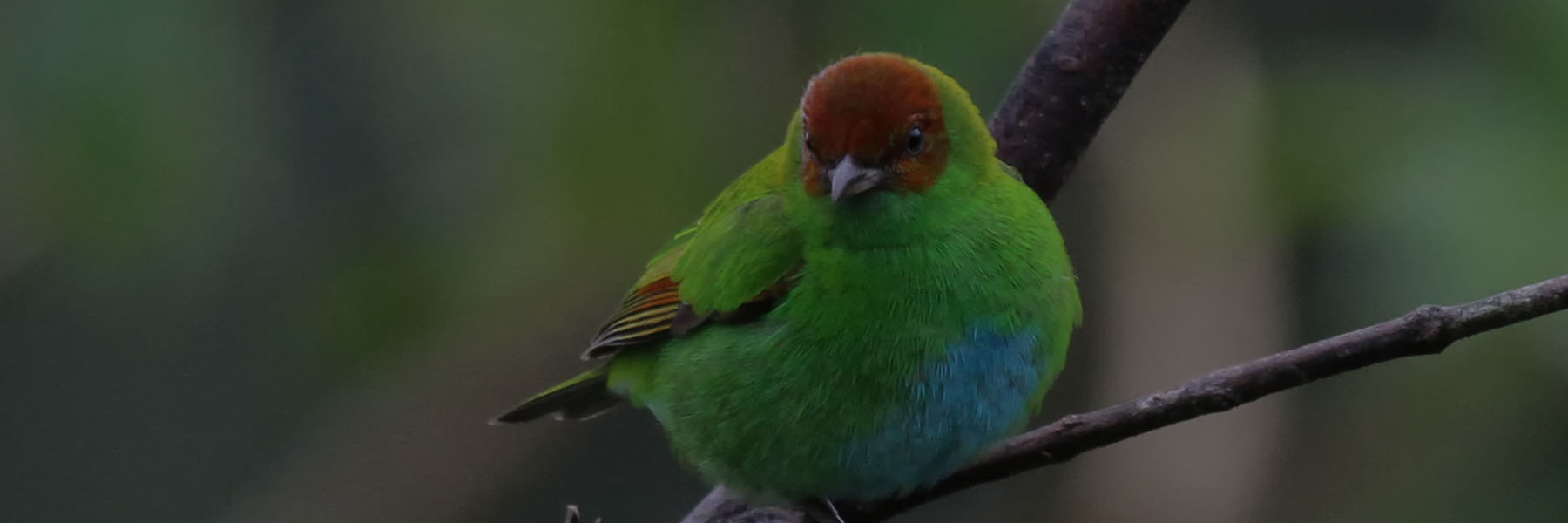Remembering My Trip to Costa Rica
Leave a CommentEvery North American birder should try to make it to the tropics at least once in their lifetime, if finances allow it. The beautiful array of birds would be worth every penny. I took my first trip in December 2011 and stayed through New Years and the first week of January 2012. I visited four different locations: the Osa Peninsula, Monteverde Cloud Forest, Arenal Volcano and San Gerardo de Dota. Even though the trip was not based on birding, I racked up 130 life birds.
The trip was suppose to be during the beginning of the dry season, however, it rained for much of the trip. This led to mostly mediocre photos – many of which I never showed anyone else since they are not up to par with my normal work. Despite this, I wanted to share the beautiful birds that I saw, even with sub-par photos. I will also mix in some of the nicer photos – though, they were few and far between!
I’m not entirely sure where to begin, so I will jump in with some of my target birds. The bird names and locations are under each photo.

Resplendent Quetzal, San Gerardo de Dota

Blue-crowned Motmot, Monteverde Cloud Forest

Chestnut-mandibled Toucan, Corcovado National Park, Osa Peninsula

Keel-billed Toucan, Arenal Observatory Lodge property, La Fortuna

Scarlet Macaw, Corcovado National Park, Osa Peninsula
Note that I also wrote a post about the Quetzal early last year where you can see more photos. This was on bird that I had great photo ops with! I plan on doing the same for the Motmot.
As expected in the tropics, I saw many species of Tanagers, most of them were very colorful.

Rufous-winged Tanager, Arenal Observatory Lodge feeders, La Fortuna

Bay-headed Tanager, Arenal Observatory Lodge property, La Fortuna

Golden-hooded Tanager, Arenal Observatory Lodge property, La Fortuna

Flame-colored Tanager, San Gerardo de Dota

White-throated Shrike-Tanager, Corcovado National Park, Osa Peninsula

Cherries Tanager with a Variable Seedeater, Corcovado National Park, Osa Peninsula

Sooty-capped Bush-Tanager, Trogon Lodge, San Gerardo de Dota

Blue-gray Tanager, Arenal Observatory Lodge property, La Fortuna

Palm Tanager, Arenal Observatory Lodge property, La Fortuna
These birds are also classified as Tanagers, but do not have it in their name. They are still equally as beautiful!

Green Honeycreeper, Arenal Observatory Lodge feeders, La Fortuna

Bananaquit, Monteverde Cloud Forest

Yellow-faced Grassquits, Monteverde Cloud Forest

Buff-throated Saltator, Arenal Observatory Lodge feeders, La Fortuna
I also saw some species of warblers that I do not get in the northeastern US.

Rufous-capped Warbler, Monteverde Cloud Forest

Buff-rumped Warbler, Arenal Observatory Lodge property, La Fortuna

Slate-throated Redstart, Monteverde Cloud Forest

Collared Redstart, San Gerardo de Dota

Tropical Parula, Arenal Observatory Lodge property, La Fortuna
Some of the birds were cool surprises.

I nearly jumped out of the car for the White-throated Magpie-Jays, Arenal Volcano

Common Potoo hiding in the brush, Sierpe River

White-whiskered Puffbird, Corcovado National Park, Osa Peninsula

Slaty Flowerpiercer, San Gerardo de Dota

Black-throated Trogon, Corcovado National Park, Osa Peninsula
One of my favorite birds had a great mating display.

Montezuma Oropendola, Arenal Observatory Lodge feeders, La Fortuna
I saw a nice variety of different Flycatchers throughout my trip.

Great Kiskadee, Arenal Observatory Lodge property, La Fortuna

Tropical Kingbird in the rain, Arenal Observatory Lodge property, La Fortuna

Social Flycatcher, Arenal Observatory Lodge property, La Fortuna

Dusky-capped Flycatcher, Corcovado National Park, Osa Peninsula

Yellowish Flycatcher, Monteverde Cloud Forest

Black-capped Flycatcher, San Gerardo de Dota

Possible Mountain Elaenia (still being identified), San Gerardo de Dota

Common Tody-Flycatcher, Arenal Observatory Lodge property, La Fortuna

Black Phoebe, Arenal Observatory Lodge property, La Fortuna
Some of the finches were pretty unique…

Large-footed Finch, San Gerardo de Dota

Thick-billed Seed Finch, Arenal Observatory Lodge property, La Fortuna
Especially, the colorful ones in the Euphonia family.

Yellow-throated Euphonia, Monteverde Cloud Forest

Tawny-capped Euphonia, Arenal Observatory Lodge property, La Fortuna

Elegant Euphonias are hidden in this photo, Monteverde Cloud Forest
I did see some nice woodpeckers, including a couple I did not get to photograph like the Pale-billed and Lineated Woodpeckers.

Acorn Woodpecker, San Gerardo de Dota

Red-crowned Woodpecker, Corcovado National Park, Osa Peninsula

Black-cheeked Woodpecker, Arenal Observatory Lodge property, La Fortuna
I also saw some birds from the Thrush family.

Clay-colored Thrush, Arenal Observatory Lodge property, La Fortuna

Sooty Robin, San Gerardo de Dota

Black-billed Nightengale-Thrush, San Gerardo de Dota

Black-headed Nightengale-Thrush, Arenal Observatory Lodge property, La Fortuna
Of course, I did see some parakeets too!

Orange-fronted Parakeets, between San Juan and Monteverde

Orange-chinned Parakeet, Corcovado National Park, Osa Peninsula
I did not see many raptors, but I was able to photograph some. Unfortunately, my Owl photos are not even good enough to show on this post and my lifer Crested Caracara is too terrible.

Common Black-Hawk, Cano Island

Yellow-headed Caracara, Sierpe River
Here are a few birds that I found by the water:

Magnificent Frigatebird, off of the Osa Peninsula

Sandwich Tern, Corcovado National Park, Osa Peninsula

Bare-throated Tiger-Heron perched over a waterfall, Corcovado National Park, Osa Peninsula
Like their North American relatives, some birds were very vocal.

Great-tailed Grackle, Monteverde Cloud Forest

Brown Jay, Monteverde Cloud Forest
Some of the larger birds just chilled and let me get a nice look.

Crested Guan, Arenal Observatory Lodge property, La Fortuna

Black Guan, Monteverde Cloud Forest

Gray-headed Chachalaque, Corcovado National Park, Osa Peninsula
But many of the smaller ones were hard to catch!

Band-backed Wren, Arenal Observatory Lodge property, La Fortuna

Rufous-collared Sparrow, San Gerardo de Dota

White-eared Ground Sparrow, Monteverde Cloud Forest

Black-cowled Oriole, Arenal Observatory Lodge property, La Fortuna

Black-hooded Antshrike, Corcovado National Park, Osa Peninsula

Ruddy Ground-Dove, Corcovado National Park, Osa Peninsula
As you can see, this post is lacking Hummingbird photos. I will put up a post specifically about them at another time since I saw so many! For now, and to close this post, I will leave you with a photo of my target hummingbird…

Violet Sabrewing, Monteverde Cloud Forest

































